Prof. Dr. Bogdan Pavković

Dr. Pavkovic is the NIT Institute CTO, Safety, in charge of Quality, and Security consultancy. Associate Professor at the Faculty of Technical Sciences - University of Novi Sad, and Functional Safety Instructor at the University of California San Diego.
Previously he served as the Technical Group Lead and Software Architect at the TTTech Automotive for 7 years;
He focuses on automotive time-triggered deterministic communication, AUTOSAR layered automotive software stack, and application of ISO26262 in real automotive projects for the industry-leading research and development activities across several design centers in Europe.
He is in charge of around 30 people working on cutting-edge computer vision and machine learning optimizations for embedded automotive platforms for top-tier OEMs from both camera and lidar domains, with regard to their appropriate design and utilization with regard to safety. He has extensive professional experience in planning, executing, leading, supporting, and analyzing research projects and technologies in computer engineering, communication technologies, and automotive software.
Dr. Pavkovic holds a Ph.D. in Computer Science on cross-stack quality of service assurance in wireless sensor networks for Smart Homes and Cities from the Grenoble Institute of Technology (France). Furthermore, he holds the Academic Safety Engineer degree from the FH CampusWien - Vienna Institute for Safety and Systems Engineering (Austria).
At the Faculty of Technical Sciences, Novi Sad, he teaches automotive courses on modern vehicle communication and functionally safe software stacks. He authored over 30 publications, holds several patents, and has given over several dozens of talks at international conferences and workshops.
References
- Bogdan Pavković, Fabrice Theoleyre, “MAC and Routing Integration in Wireless Sensor Networks in Using Cross-Layer Techniques”, Communication Systems: Techniques and Applications by IGI Global, http://doi.org/10.4018/978-1-4666-0960-0.ch011
- Bogdan Pavkovic, Andrzej Duda, Won-Joo Hwang, Fabrice Theoleyre, “Efficient Topology Construction for RPL over IEEE 802.15.4 in Wireless Sensor Networks”, Elsevier Ad Hoc Networks Journal, https://doi.org/10.1016/j.adhoc.2013.08.009
- Miladin Sandić, Bogdan Pavković, Nikola Teslić, “TTEthernet Mixed-Critical Communication: Overview and Impact of Faulty-Switches”, IEEE Consumer Electronics Magazine, https://doi.org/10.1109/MCE.2020.2978224
- Bogdan Pavković, Miladin Sandić, Nikola Teslić, “A genetic simulation strategy: Application to single-fault analysis of TTEthernet synchronization protocol”, Elsevier Journal of Systems Architecture, https://doi.org/10.1016/j.sysarc.2021.102169
- Ivan Mezei, Milan Lukic, Lazar Berbakov, Bogdan Pavkovic, and Boris Radovanovic, “Grapevine Downy Mildew Warning System Based on NB-IoT and Energy Harvesting Technology”, Elsevier Journal of Systems Architecture, https://doi.org/10.3390/electronics11030356
Courses
Dive into the specifics of functional safety in automotive on the basis of ISO 26262 and ISO 21448 SOTIF.
The course participants are familiarized with the typical functional safety standards (generic IEC 61508, machinery IEC 62061 and ISO 13849, and automotive SOTIF – ISO/PAS 21448 and ISO 26262), their genesis, their role, and their applicability in real-world projects. The course gives a foundation for understanding functional safety standards in general and their key concepts, including risk assessment matrices/graphs and safety integrity levels. The specific focus of the course is the automotive functional safety standard ISO 26262, which is examined in detail. The philosophy of the ISO26262 standard, build-up, and process sequences are given. Focus is put on the explanation and interpretation of major parts of the ISO 26262. The lectures are accompanied by a running example with exercises, to highlight and support the application of important parts of this standard, including the practical system decomposition, safety functions definition, risk assessment, and qualification of safety functions with the respected requirements in terms of Automotive Safety Integrity Levels (ASIL).
Course topics:
- Get an overview and understanding of functional safety definitions, concepts, and summary of relevant standards (generic IEC 61508, machinery IEC 62061 and ISO 13849, and automotive SOTIF – ISO/PAS 21448 and ISO 26262).
- Understand the lifecycle and mandatory processes of automotive ISO26262 standard: from management, through concept, system, hardware, and software level.
- Define a functional item on a vehicle level.
- Perform hazard assessment and risk analysis, establish an ASIL level for an item and perform ASIL decomposition.
- Perform system and requirements engineering when developing Functional and Technical Safety Concepts.
- Understand and select appropriate work products while performing the tailoring of the ISO26262 lifecycle.
- Be able to select appropriate methods on System, Hardware and Software level.
- Be able to specify, design, implement, and test Software according to ISO 26262 guideliness.
- Prepare, document, and execute Verification and Validation activities on different levels of integration, and to provide proofs for building the Safety Case.
Requirements
Hardware: Computer with Internet connection, working speakers and microphone.
Software: Chrome browser.
Prior knowledge: Students should have basic engineering knowledge in either one of the following disciplines: electrical engineering, computer engineering, or mechanical engineering.







